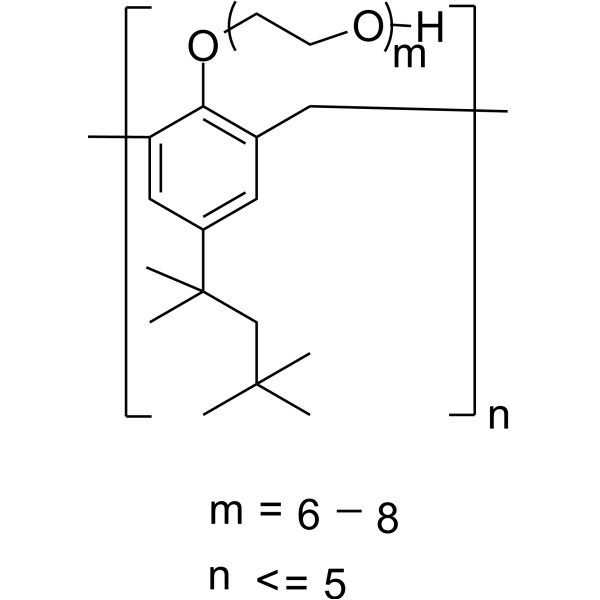
| 规格 | 价格 | 库存 | 数量 |
|---|---|---|---|
| 500mg |
|
||
| 1g |
|
||
| Other Sizes |
|
| 靶点 |
Non-ionic liquid polymer
|
|---|---|
| 体外研究 (In Vitro) |
Tyloxapol (100 μg/mL) 会导致 HEK293 细胞消融 [2]。 Tyloxapol 促进细胞核碎裂和阿根廷细胞核的发育 [2]。 Tyloxapol 会增加肺静脉风险,产生上皮细胞和红细胞毒性,并促进人类 Jurkat T 占用 [2]。
|
| 体内研究 (In Vivo) |
Triton WR-1339通过与谷胱甘肽耗竭以及血浆、肝脏和脑中GST、SOD、GSH-Px和CAT活性相关的TBARS升高来增加氧化应激。Triton WR-1339诱导DNA断裂,抑制脑内乙酰胆碱酯酶和单胺氧化酶的活性。Triton WR-1339治疗后,血浆生化参数包括转氨酶、磷酸酶、乳酸脱氢酶、尿素、肌酐、胆红素、总脂质、胆固醇、甘油三酯和LDL升高,而总蛋白、白蛋白和高HDL降低。肝脏和背主动脉的组织病理学和形态测量分析显示,Triton WR-1339治疗后发生了变化。大豆油与Triton WR-1339的存在通过降血脂作用将其肝毒性和神经毒性降至最低,并减轻了氧化损伤[1]。
|
| 酶活实验 |
血浆和脑乙酰胆碱酯酶和单胺氧化酶的测定[1]
根据Ellman、Courtney、Anders和Featherstone(1961)的方法,使用碘化乙酰胆碱作为底物,估算血浆和组织上清液中的乙酰胆碱酯酶(AChE;EC 3.1.1.7)活性。根据Sandler、Reveley和Glover(1981)的方法估算血浆和组织提取物中单胺氧化酶的活性。 蛋白质估算[1] 前面提到的组织提取物的蛋白质含量是使用牛血清白蛋白作为标准,通过Lowry、Rosebrough、Farr和Randall(1951)的方法测定的。 生化参数[1] 使用SENTINEL CH的试剂盒测定血浆和肝脏天冬氨酸氨基转氨酶(AST;EC 2.6.1.1)、丙氨酸氨基转氨酶(ALT;EC 2.6.1.2)和乳酸脱氢酶(LDH;EC 1.1.1.27)活性。使用SENTINET CH的试剂袋分析储存的血浆样品的尿素和肌酐浓度。 血浆总胆固醇、高密度脂蛋白(HDL)和甘油三酯水平通过使用胆固醇和甘油三酯试剂盒估计,span diagnostics有限公司,印度。按照制造商的说明进行了分析。 |
| 细胞实验 |
固体脂质纳米粒(SLN)因其生物相容性、控释和被动药物靶向等优越的药物递送性能而受到赞誉。然而,SLN及其成分的细胞毒性,特别是在较长一段时间内,尚未得到详细研究。我们研究了使用表面活性稳定剂Tyloxapol(Tyl)制备固体脂质颗粒(SLP)的关键问题及其对细胞功能和存活率的影响。SLP由山嵛酸酯、磷脂和稳定剂Tyloxapol(Tyl)或Lutrol(Lut)组成,通过脂质熔融法制备,用荧光染料标记,并在Jurkat或HEK293细胞上进行测试。纳米颗粒迅速内化并表现出细胞质定位。用SLP Tyl孵育细胞会产生剂量和时间依赖性的细胞生长抑制作用,也会引起中度和延迟的细胞毒性Tyloxapol溶液或SLP Tyl分散液导致HEK293细胞分离、细胞增殖减少和细胞形态改变。细胞周期分析显示,虽然SLP Tyl和Tyloxapol溶液的不利影响最初是相似的,但较长的孵育时间会导致用SLP Ty1分散液孵育的细胞部分恢复,而Tyloxaapol)溶液的存在会诱导凋亡细胞死亡。这些发现表明,Tyloxapol是用于细胞内递送的SLP的不利稳定剂,并加强了稳定剂在具有最小细胞毒性的SLP设计中的作用。
|
| 动物实验 |
Animal/Disease Models: 21 adult male Wistar rats, 11-12 weeks old, weighing 180-200 g[1].
Doses: 50 mg/kg. Route of Administration: intraperitoneal (ip) injection, BW, every other day. Experimental Results: TBARS levels were Dramatically increased in rat plasma, liver and brain (P < 0.05), while antioxidant enzymes (GPx, GST, CAT, SOD) were inhibited. Induces DNA fragmentation and inhibits the activity of acetylcholinesterase and monoammonium oxidase in the brain. Animals were treated with Triton WR-1339 (50 mg/kg BW) and soybean oil (50 mg/kg BW) for 28 days. Oxidative stress markers; antioxidant enzymes activity; biochemical parameters, such as acetylcholinesterase and mono aminoxidase, transaminases, phosphatases, lactate dehydrogenase, urea, creatinine, bilirubin, and lipid profile; DNA fragmentation; as well as histopathological and morphmetric analysis of the liver and dorsal aorta were investigated.[1] Twenty-one adult male Wistar rats, aged 11–12 weeks weighing 180–200 g, were used in the present experiments. Animals were caged in groups and given food and water ad libitum. After 2 weeks of acclimation, animals were divided randomly into three groups; seven rats in each group. Group I (control group) rats were treated with a vehicle (injected intraperitoneally with saline and treated orally with corn oil). Group II was injected intraperitoneally with 50 mg/kg BW of Triton WR-1339 every other day. Group III was treated orally with 50 mg/kg BW of soybean oil every day plus 50 mg/kg BW of Triton WR-1339 every other day. The dose of Triton WR-1339 was chosen according to Bhuvaneswari and Sasikumar (2013). The dose of soybean oil was chosen according to Mallo et al. (2013a, b). Rats were administered their respective doses for 28 days.[1] |
| 参考文献 |
|
| 其他信息 |
Tyloxapol is a polymeric compound resulting from the reaction of 4-(1,1,3,3-tetramethylbutyl)phenol with formaldehyde to give a chain in which 6-8 molecules are linked together by CH2 groups ortho to the phenolic hydroxy groups, which have then undergone reaction with oxirane to give polyoxyethyleneoxy moieties, Ar(OCH2CH2)xOH, where x = 8-10. A nonionic liquic polymer, it inhibits lipoprotein lipase and hence clearance of triglyceride from the plasma, so is used to induce hyperlipidaemia in test animals. Also used as a surfactant to aid liquefaction and removal of mucus- and pus-containing bronchopulmonary secretions. It has a role as an inhibitor, an excipient, a surfactant and an apoptosis inducer.
See also: Tyloxapol (annotation moved to). |
| 分子式 |
(C14H22O.C2H4O.CH2O)X
|
|---|---|
| 分子量 |
261.38 (monomer)
|
| 精确质量 |
280.203
|
| CAS号 |
25301-02-4
|
| 相关CAS号 |
25301-02-4
|
| PubChem CID |
71388
|
| 外观&性状 |
Colorless to light yellow liquids
|
| 密度 |
1.1
|
| 沸点 |
282.3ºC at 760 mmHg
|
| 闪点 |
148.3ºC
|
| 蒸汽压 |
0.00198mmHg at 25°C
|
| LogP |
4.573
|
| tPSA |
49.83
|
| 氢键供体(HBD)数目 |
1
|
| 氢键受体(HBA)数目 |
3
|
| 可旋转键数目(RBC) |
3
|
| 重原子数目 |
20
|
| 分子复杂度/Complexity |
204
|
| 定义原子立体中心数目 |
0
|
| SMILES |
C1=C(O)C=CC(C(C)(C)CC(C)(C)C)=C1.C1OC1.C=O
|
| InChi Key |
MDYZKJNTKZIUSK-UHFFFAOYSA-N
|
| InChi Code |
InChI=1S/C14H22O.C2H4O.CH2O/c1-13(2,3)10-14(4,5)11-6-8-12(15)9-7-11;1-2-3-1;1-2/h6-9,15H,10H2,1-5H3;1-2H2;1H2
|
| 化学名 |
formaldehyde;oxirane;4-(2,4,4-trimethylpentan-2-yl)phenol
|
| 别名 |
Tyloxapol; 25301-02-4; Macrocyclon; Tyloxypal; Triton WR-1339;
|
| HS Tariff Code |
2934.99.9001
|
| 存储方式 |
Powder -20°C 3 years 4°C 2 years In solvent -80°C 6 months -20°C 1 month 注意: 本产品在运输和储存过程中需避光。 |
| 运输条件 |
Room temperature (This product is stable at ambient temperature for a few days during ordinary shipping and time spent in Customs)
|
| 溶解度 (体外实验) |
H2O : ~120 mg/mL
Ethanol : ~100 mg/mL DMSO : ≥ 38 mg/mL |
|---|---|
| 溶解度 (体内实验) |
配方 1 中的溶解度: 100 mg/mL (Infinity mM) in PBS (这些助溶剂从左到右依次添加,逐一添加), 澄清溶液; 超声助溶。
请根据您的实验动物和给药方式选择适当的溶解配方/方案: 1、请先配制澄清的储备液(如:用DMSO配置50 或 100 mg/mL母液(储备液)); 2、取适量母液,按从左到右的顺序依次添加助溶剂,澄清后再加入下一助溶剂。以 下列配方为例说明 (注意此配方只用于说明,并不一定代表此产品 的实际溶解配方): 10% DMSO → 40% PEG300 → 5% Tween-80 → 45% ddH2O (或 saline); 假设最终工作液的体积为 1 mL, 浓度为5 mg/mL: 取 100 μL 50 mg/mL 的澄清 DMSO 储备液加到 400 μL PEG300 中,混合均匀/澄清;向上述体系中加入50 μL Tween-80,混合均匀/澄清;然后继续加入450 μL ddH2O (或 saline)定容至 1 mL; 3、溶剂前显示的百分比是指该溶剂在最终溶液/工作液中的体积所占比例; 4、 如产品在配制过程中出现沉淀/析出,可通过加热(≤50℃)或超声的方式助溶; 5、为保证最佳实验结果,工作液请现配现用! 6、如不确定怎么将母液配置成体内动物实验的工作液,请查看说明书或联系我们; 7、 以上所有助溶剂都可在 Invivochem.cn网站购买。 |
计算结果:
工作液浓度: mg/mL;
DMSO母液配制方法: mg 药物溶于 μL DMSO溶液(母液浓度 mg/mL)。如该浓度超过该批次药物DMSO溶解度,请首先与我们联系。
体内配方配制方法:取 μL DMSO母液,加入 μL PEG300,混匀澄清后加入μL Tween 80,混匀澄清后加入 μL ddH2O,混匀澄清。
(1) 请确保溶液澄清之后,再加入下一种溶剂 (助溶剂) 。可利用涡旋、超声或水浴加热等方法助溶;
(2) 一定要按顺序加入溶剂 (助溶剂) 。